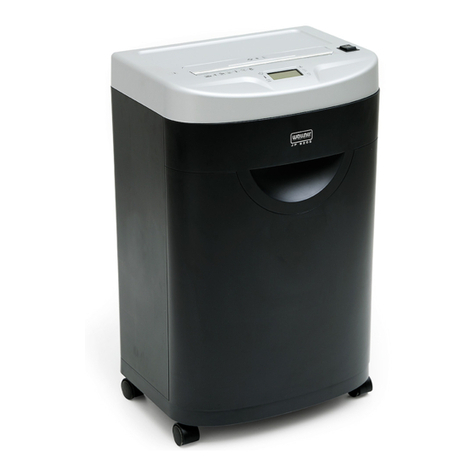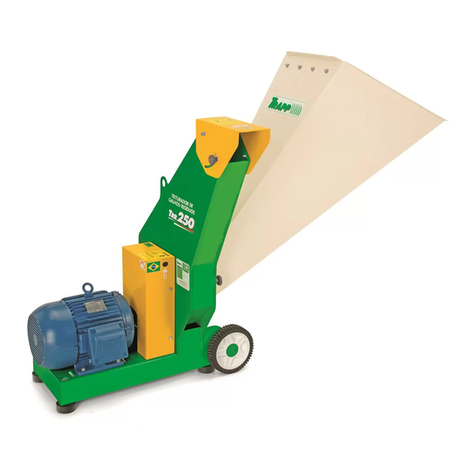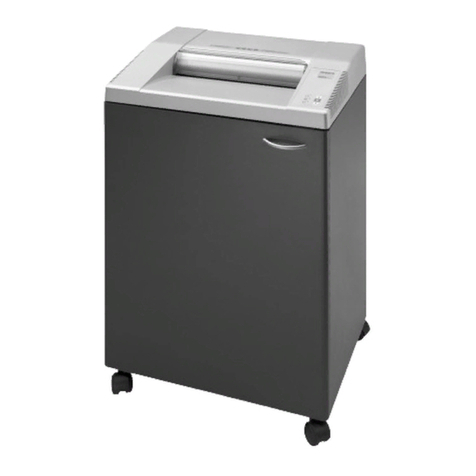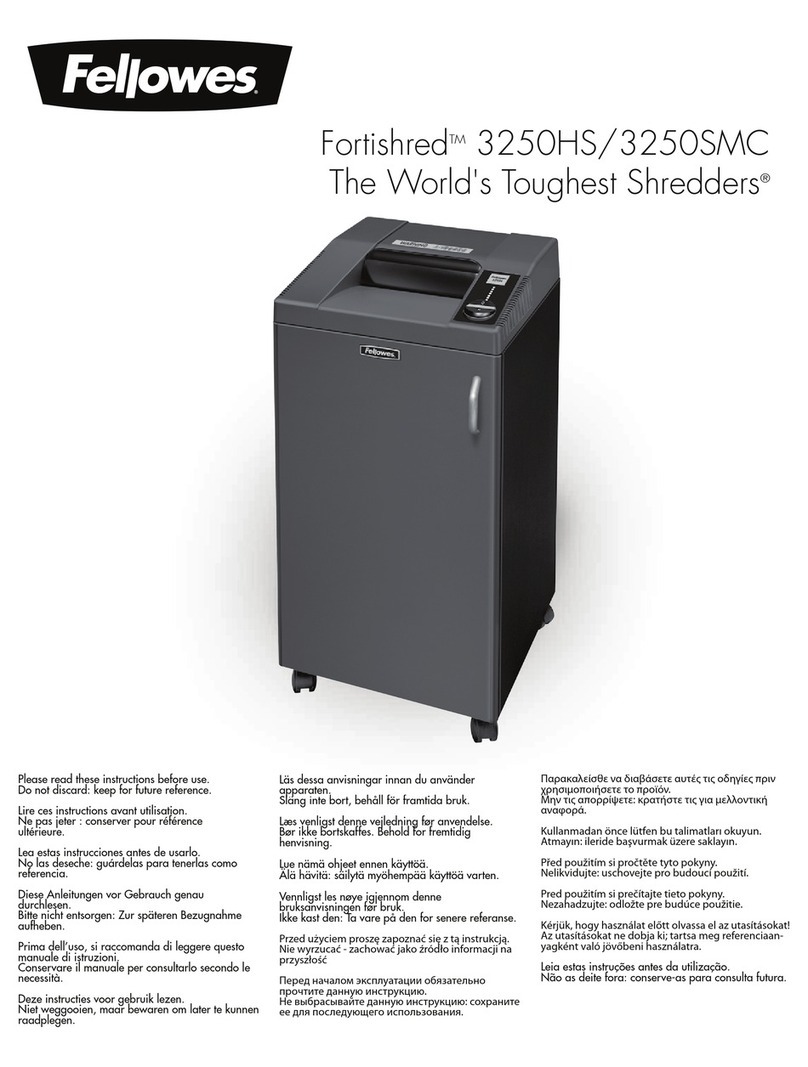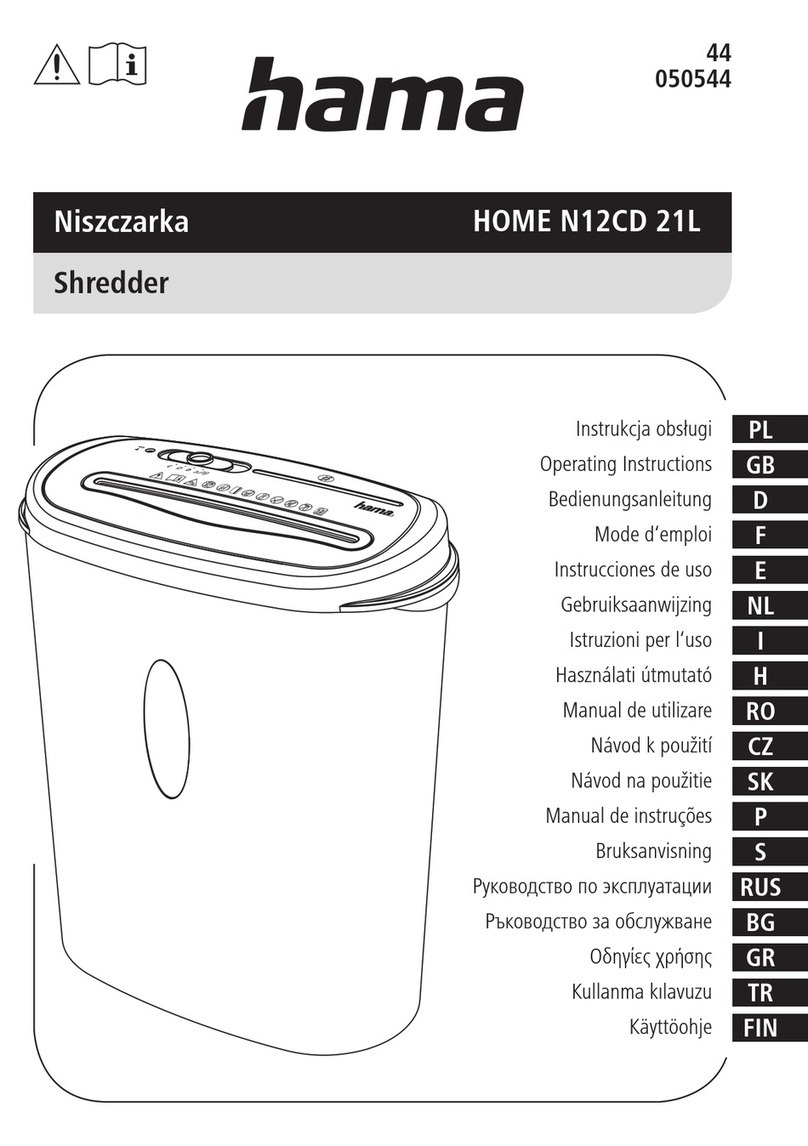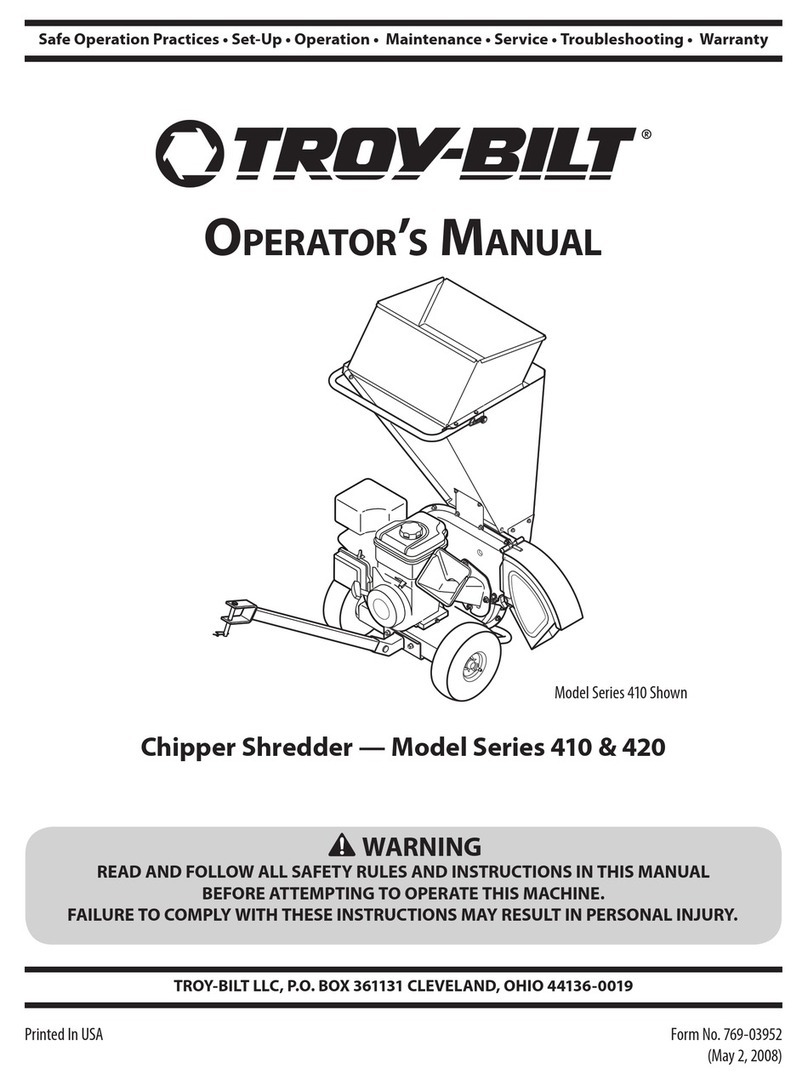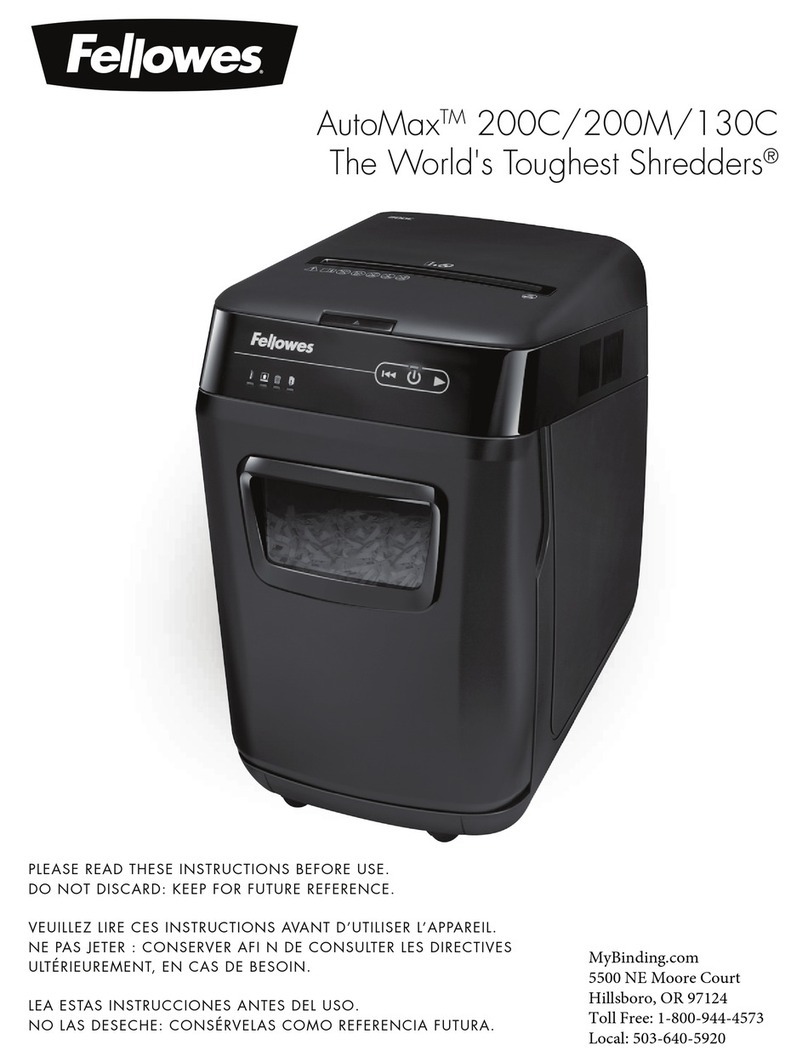NINE ZERO NINE 909 User manual

24 0 0 W
G A R DE N
S HRE D DE R
W I T H B UCK E T
INSTRUCTION MANUAL
M909

Warranty 2
Introduction 3
Environmental protection 3
Description of symbols 3
Specifications 3
General safety rules 4
Additional safety rules for shredders 5
Accessories 6
Unpacking 6
Know your product 7
Assembly 8
Attaching the wheels 8
Operation of the shredder 9
Changing direction of rotation 9
Overload protection 9
Mulching 9
Composting 10
Cleaning 10
Maintenance and storage information 11
Power cord maintenance 11
Warranty Power Tools
For full details please visit us at www.909.com
CONTENTS
2

Description of symbols
The rating plate on your tool may show symbols. These
represent important information about the product or
instructions on its use.
Wear hearing protection.
Wear eye protection.
Wear breathing protection.
Conforms to relevant standards
for electromagnetic compatibility.
Read these instructions for use carefully.
Wear protective gloves.
WARNING. Keep spectators away. Beware of
objects being flung out.
WARNING. Do not put hands or feet under the
cover of the machine when it is running.
WARNING. Rotating blades.
The blades will continue to rotate after the machine
has been switched off.
WARNING. Remove the plug from the wall socket
before carrying out any kind of maintenance.
Do not leave this electrical tool in the rain.
WARNING. Rotating blades keep hands away
from discharge.
Specifications
Voltage: 230–240 V ~ 50Hz
Input power: S1: 2000W, S6: 2400W
Speed: 2850 min-1
Maximum shredding diameter: 45 mm
Blade length: 70 mm
Insulation: Earthed appliance
Weight: 24.5 Kg
Protection: IPX4
Introduction
Your new 909 power tool will more than satisfy
your expectations. It has been manufactured under
stringent 909 Quality Standards to meet superior
performance criteria.
You will find your new tool easy and safe to operate,
and, with proper care, it will give you many years
of dependable service.
CAUTION. Carefully read through this entire Instruction
Manual before using your new 909 Power Tool. Take
special care to heed the Cautions and Warnings.
Your 909 power tool has many features that will make
your job faster and easier. Safety, performance, and
dependability have been given top priority in the
development of this tool, making it easy to maintain
and operate.
Environmental protection
Recycle unwanted materials instead
of disposing of them as waste. All tools,
hoses and packaging should be sorted,
taken to the local recycling centre and
disposed of in an environmentally safe way.
3

General safety rules
WARNING. Read all safety warnings and all instructions.
Failure to follow the warnings and instructions may result in
electric shock, fire and/or serious injury.
Save all warnings and instructions for future reference.
The term “power tool” in the warnings refers to your mains-
operated (corded) power tool or battery-operated (cordless)
power tool.
1) Work area safety
a) Keep work area clean and well lit. Cluttered or dark
areas invite accidents.
b) Do not operate power tools in explosive
atmospheres, such as in the presence of flammable
liquids, gases or dust. Power tools create sparks which
may ignite the dust or fumes.
c) Keep children and bystanders away while operating
a power tool. Distractions can cause you to lose control.
2) Electrical safety
a) Power tool plugs must match the outlet. Never
modify the plug in any way. Do not use any adapter
plugs with earthed (grounded) power tools. Unmodified
plugs and matching outlets will reduce risk of electric
shock.
b) Avoid body contact with earthed or grounded
surfaces, such as pipes, radiators, ranges and
refrigerators. There is an increased risk of electric
shock if your body is earthed or grounded.
c) Do not expose power tools to rain or wet conditions.
Water entering a power tool will increase the risk of
electric shock.
d) Do not abuse the cord. Never use the cord for
carrying, pulling or unplugging the power tool.
Keep cord away from heat, oil, sharp edges or
moving parts. Damaged or entangled cords increase
the risk of electric shock.
e) When operating a power tool outdoors, use an
extension cord suitable for outdoor use. Use of a
cord suitable for outdoor use reduces the risk of electric
shock.
f) To reduce the risk of electric shock, the manufacturer
recommends the use of a residual current device
with a rated residual current of 30mA or less at
all times.
3) Personal safety
a) Stay alert, watch what you are doing and use
common sense when operating a power tool. Do not
use a power tool while you are tired or under the
influence of drugs, alcohol or medication. A moment
of inattention while operating power tools may result in
serious personal injury.
b) Use personal protective equipment. Always wear eye
protection. Protective equipment such as dust mask,
non-skid safety shoes, hard hat, or hearing protection used
for appropriate conditions will reduce personal injuries.
c) Prevent unintentional starting. Ensure the switch
is in the off-position before connecting to power
source and/or battery pack, picking up or carrying
the tool. Carrying power tools with your finger on the
switch or energising power tools that have the switch
on invites accidents.
d) Remove any adjusting key or wrench before
turning the power tool on. A wrench or a key left
attached to a rotating part of the power tool may result
in personal injury.
e) Do not overreach. Keep proper footing and balance
at all times. This enables better control of the power tool
in unexpected situations.
f ) Dress properly. Do not wear loose clothing or
jewellery. Keep your hair, clothing and gloves away
from moving parts. Loose clothes, jewellery or long hair
can be caught in moving parts.
g) If devices are provided for the connection of dust
extraction and collection facilities, ensure these are
connected and properly used. Use of dust collection
can reduce dust-related hazards.
4

4) Power tool use and care
a) Do not force the power tool. Use the correct power
tool for your application. The correct power tool will
do the job better and safer at the rate for which it was
designed.
b) Do not use the power tool if the switch does not turn
it on and off. Any power tool that cannot be controlled
with the switch is dangerous and must be repaired.
c) Disconnect the plug from the power source and/or
the battery pack from the power tool before making
any adjustments, changing accessories, or storing
power tools. Such preventive safety measures reduce
the risk of starting the power tool accidentally.
d) Store idle power tools out of the reach of children
and do not allow persons unfamiliar with the power
tool or these instructions to operate the power tool.
Power tools are dangerous in the hands of untrained users.
e) Maintain power tools. Check for misalignment or
binding of moving parts, breakage of parts and any
other condition that may affect the power tool’s
operation. If damaged, have the power tool repaired
before use. Many accidents are caused by poorly
maintained power tools.
f ) Keep cutting tools sharp and clean. Properly
maintained cutting tools with sharp cutting edges are
less likely to bind and are easier to control.
g) Use the power tool, accessories and tool bits etc.
in accordance with these instructions, taking into
account the working conditions and the work to be
performed. Use of the power tool for operations different
from those intended could result in a hazardous situation.
h) This appliance is not intended for use by persons
(including children) with reduced physical, sensory
or mental capabilities, or lack of experience and
knowledge, unless they have been given supervision or
instruction concerning use of the appliance by a person
responsible for their safety.
i) Children should be supervised to ensure that they do
not play with the appliance.
5) Service
a) Have your power tool serviced by a qualified repair
person using only identical replacement parts. This
will ensure that the safety of the power tool is maintained.
Additional safety rules for shredders
• This appliance is not intended for use by young children
or infirm persons unless they have been adequately
supervised by a responsible person to ensure that they
can use the appliance safely.
• Young children should be supervised to ensure that they
do not play with the appliance.
• Wear protective gloves, protective glasses and hearing
protectors. Avoid loose clothing.
• Always stand steadily and in balance. Do not stretch
towards the machine.
• During use, the machine should be level and on a
firm surface.
• Ensure that all screws and nuts are properly tightened
before use.
• Only use the machine in dry conditions and never
outdoors when it is raining.
• Never use the machine with damaged safety devices
or without protection.
• Keep hands, other parts of your body and clothing away
from the feeding hopper and the discharge chute.
• Keep your face and the rest of your body away from the
feeding hopper.
• Do not leave the machine unsupervised, switch off the
motor and disconnect the plug.
• Hard objects such as stones, bottle, cans or pieces of
metal must not be fed into the inlet chute. This can cause
damage to the machine.
• If the machine becomes blocked, stop the motor and
disconnect the plug. Pull out any objects and check
for damage.
5

• If the fuse blows or if the overload protection is triggered,
this is a sign that the machine is overloaded and/or
that too many appliances are connected to the same
extension cable. Check the cause and remedy. Do not
install a more powerful fuse.
• Do not tug on the extension cable. Do not hold the cable
taut. This can cause damage in the plugs or in
the cables insulation. Such damage is invisible but can
be dangerous.
• Always keep the extension cable away from the
machine. Disconnect the plug from the electric socket
and check the cable regularly for signs of damage
or ageing. Do not use the machine with a damaged
extension cable.
• If the cable is damaged, it must be replaced by an
authorised service centre in order to avoid a hazard.
• Never move the machine by pulling the cable. The
machine must not be moved with the motor running.
Wear goggles
Wear earmuffs
Wear a breathing mask
WARNING. We recommend the use of a residual current
device with a residual current rating of 30mA or less.
Accessories
The 909 Shredder is supplied with the following accessories
as standard:
• Allen key
• Push stick
Unpacking
Due to modern mass production techniques, it is unlikely
that your power tool is faulty or that a part is missing.
If you find anything wrong, do not operate the tool
until the parts have been replaced or the fault has
been rectified. Failure to do so could result in serious
personal injury.
6

Know your product
1. Shredder body
2. On/off switch
3. Bucket
4. Overload protection
button
5. Handle
6. Inlet chute
7. Leg frame / support
8. Wheel (x 2)
9. Wheel cover (x 2)
10. Axle
11. Axle tube
12. Wheel bush (x 2)
13. Support fixing screws
14. Washer (x 4)
15. Nut (x 2)
16. Allen key
17. Push stick
18. Feet
19. Feet screws (x 4)
20. Screwdriver
/ socket spanner
6
2
1
3
4
5
8
9
10
11
12
14
15
13
18
19
16
20
17
7
7

Assembly
Remove everything from
the carton.
WARNING. You may need
assistance when lifting the
machine out of the box and
assembling.
1. Lift out the leg frame and then the bucket from
the carton.
2. Lift out the main motor housing and place onto the
leg frame. Ensure the motor housing sits well onto
the leg frame.
3. Using the screws and washer provided screw the
housing onto the leg frame.
4. Lift top of the unit into place ensure the safety interlock is
located into the slot and the screw is tightened fully.
Attaching the wheels
1. Push the wheel axle
through the holes and tube
on the leg support.
2. Position the washers (14),
and wheel bushes (12) on
each end of the axle.
Push the wheels (8) onto
each end of the axle (10).
Note. The wheels must be fitted the correct way round to
allow the nuts to tighten on each end of the axle.
8

3. Position the remaining washers (14) and the locking nuts
(15) on each end of the axle and tighten both the wheel
nuts using the spanner provided.
4. Push the wheel covers (9)
firmly onto the wheels.
5. Fit the feet to the leg frame
with the two screws for
each. Use the screwdriver
provided.
WARNING. Take care when
tilting the unit onto its wheels
as the unit has an uneven
weight distribution when tilted
and during wheeled transportation.
Operation of the shredder
Starting the motor
WARNING. Ensure that the
shredder is empty before
starting the motor.
1. Connect the shredder power
cord to an appropriate
extension cord and plug it
in to the mains power.
2. To start the motor, press the
green button.
Stopping the motor
Stop the motor by pressing the
red section of the on/off switch
(2) marked O.
WARNING. Do not feed in any
material after the motor has
been stopped. This will get
caught in the machine and can
make restarting impossible.
Overload protection
The shredder is equipped with a built-in motor protection
which prevents the motor being overloaded.
In the event of overloading,
the current is broken and
the main switch is turned off
automatically .
Disconnect shredder
from power supply before
attempting to unblock any
jams.
Allow at least 5 minutes for
the motor to cool down.
Push in the overload protection button (4) to re-set, mains
power can now be switched on.
Mulching
The following types of material can be shredded in the
shredder:
• Twigs and branches.
• Waste from cutting bushes.
• Waste from hedge-trimming.
Examples of materials which are not suitable for
shredding include:
• Glass, metal, plastic bags, stones, fabric,
earth covered roots.
• Waste that does not have a firm consistency,
e.g. kitchen waste.
9

• Soft leafy material. To prevent damage to the machine,
you are recommended not to exceed the following
maximum sizes of twigs and branches:
• 45mm in diameter.
The material that is to be shredded is fed into the inlet chute
(6) and, assuming it is not too bulky, in most cases will
be pulled down into the cutter and emptied either into the
bucketed provided or other suitable container.
Branches and twigs should be mulched shortly after being
cut. They become extremely hard when they dry out, and
the maximum diameter of what can be mulched is reduced.
Heavy material or twigs will jam the blades if you let the
machine cut continually. A large proportion of garden waste
contains a lot of water and therefore sticks easily. Such
material should be allowed to dry for a few days before
being processed.
Check all the material you want to shred carefully. Make
sure it doesn’t contain any stones or nails as this might
severely damage the shredder.
Be aware of vibrations. Heavy vibrations are caused by
damaged or worn out blades. Store the shredder indoors in
a dry place.
Composting
The processed material can be composted in various ways:
• The material can be placed in a heap directly on the
ground (cold composting).
• The material can be placed in a plastic container,
wooden crate, skeleton container or similar (cold
composting).
• The material can be placed in an insulated compost
holder. The heat is then held for longer and the rotting
process also continues during the winter. This method
produces faster results (warm composting).
• The material can be spread directly onto the garden
(surface composting).
Cleaning
Always clean the shredder after each use.
WARNING. Never use a high-pressure washer or running
water when cleaning the shredder!
Brush away dirt and plant residue which may be caught
in the cutter. Wipe clean the outside of the shredder with
a cloth which has been moistened with a mild detergent
and water.
On occasion the build up of chippings need to be cleaned.
Undo the safety switch screw.
Pivot the top of the unit off
the shredder, this will allow
access to the blades and the
inner chute.
Using a brush, clean away any
debris that may of built up.
This also allows access to
the blades, which can be
removed, to be sharpened or
turned over as they have two
cutting edges.
Use the allen key provided to
undo the grub screws on the
blades. Put in a safe place,
so that they can tightened
up again once the blade
has been turned over or
sharpened. Tighten the grub screws.
10

Maintenance and storage information
WARNING. Prior to cleaning or any maintenance, always
ensure the power plug has been removed from the
electrical power supply.
Always wear protective gloves to avoid injury.
Generally speaking, shredders require very little
maintenance. In order to maintain the efficiency of the
machine and to achieve a long service life, observe
the following:
• Keep the air openings clean and free of
obstructing material.
• Check the customer-installed nuts and
screws (tighten if necessary).
• Spray the spiral cutter after each use with an
environmentally-friendly, biodegradable spray
oil to protect against corrosion.
Power cord maintenance
If the supply cord needs replacing, the task must be carried
out by the manufacturer, the manufacturer’s agent, or an
authorised service centre in order to avoid a safety hazard.
11

12
Table of contents
Popular Paper Shredder manuals by other brands
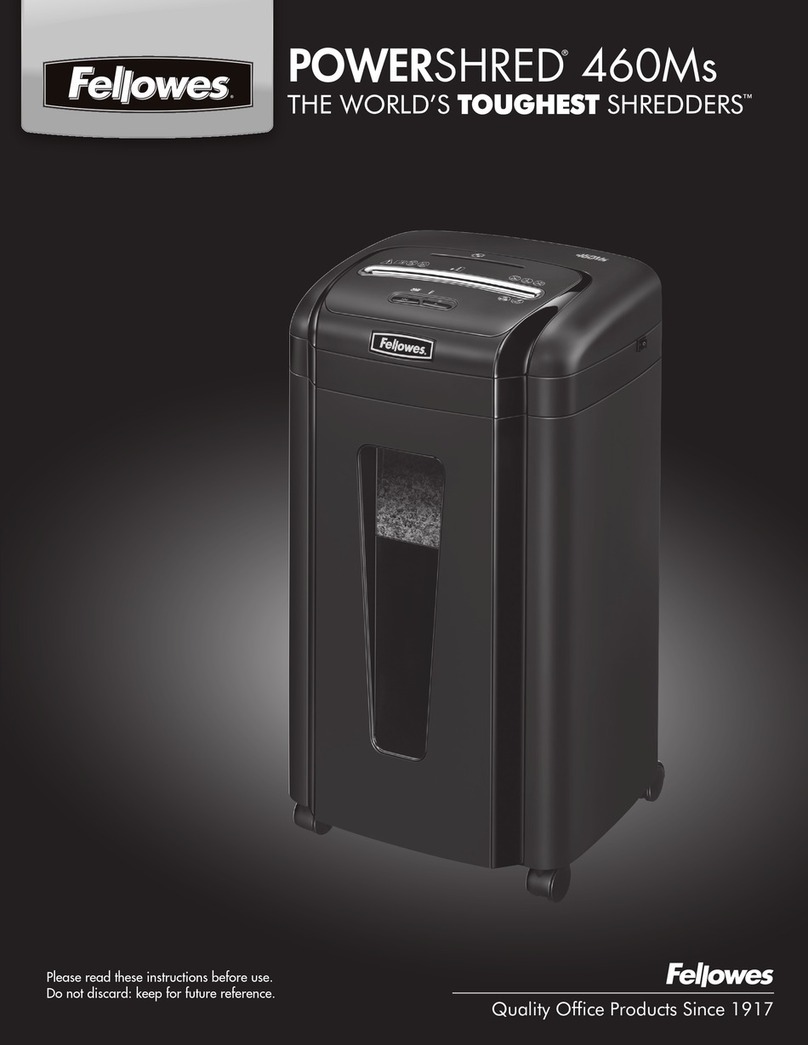
Fellowes
Fellowes 460Ms quick guide
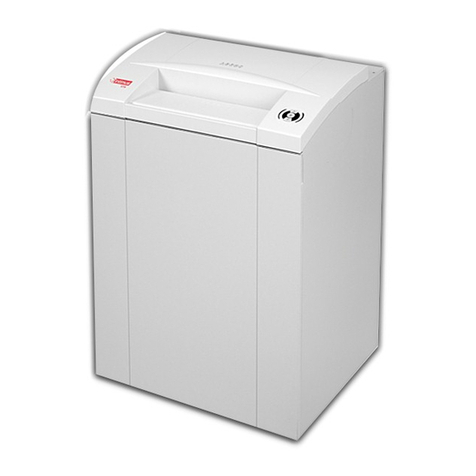
Martin Yale
Martin Yale intimus 130SP2 operating instructions
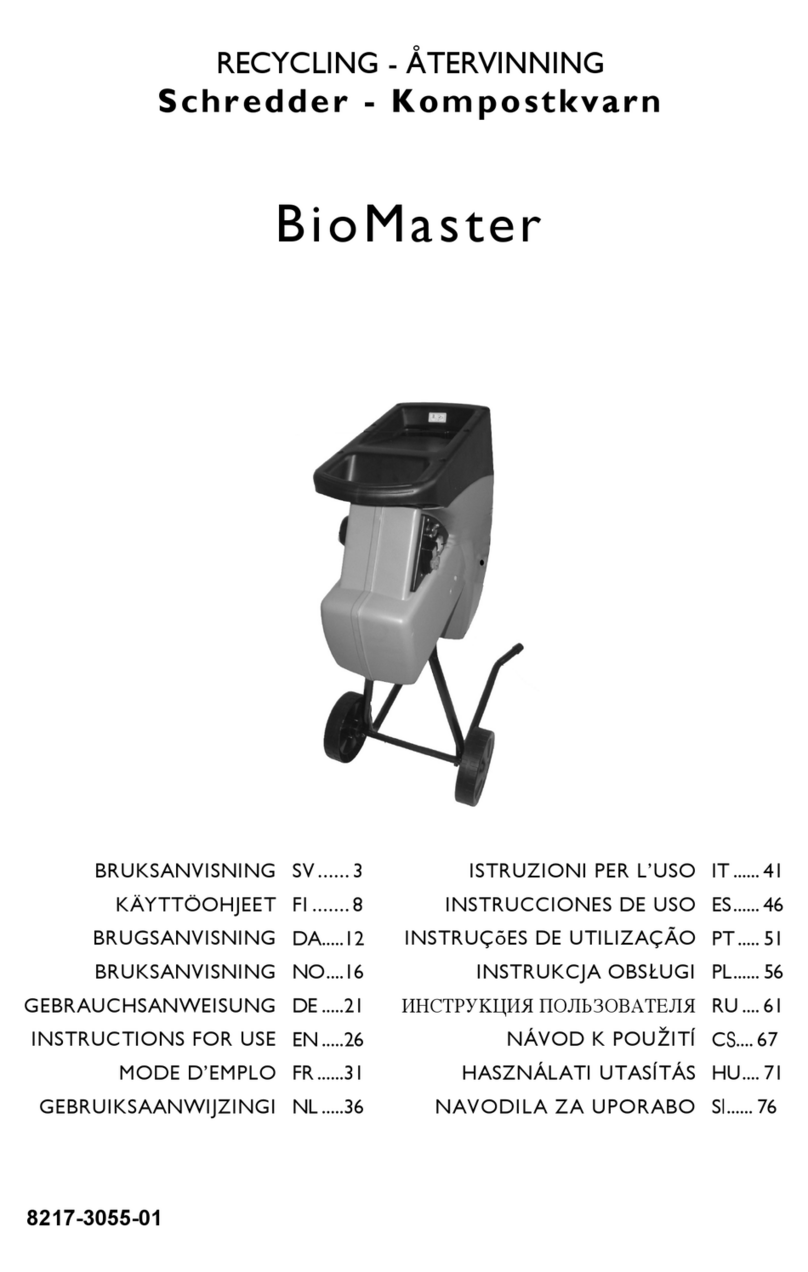
Stiga
Stiga BioMaster Instructions for use

Schleicher & Co.
Schleicher & Co. intimus 802CC operating instructions
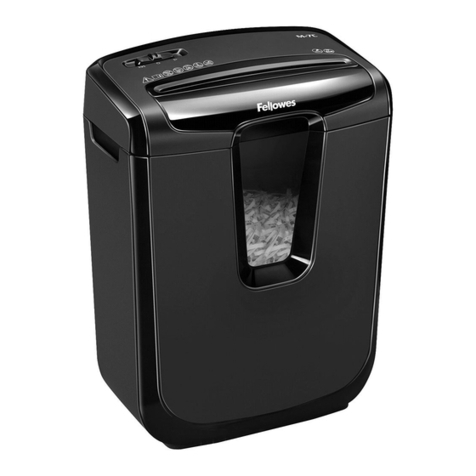
Fellowes
Fellowes Powershred M-7Cm manual
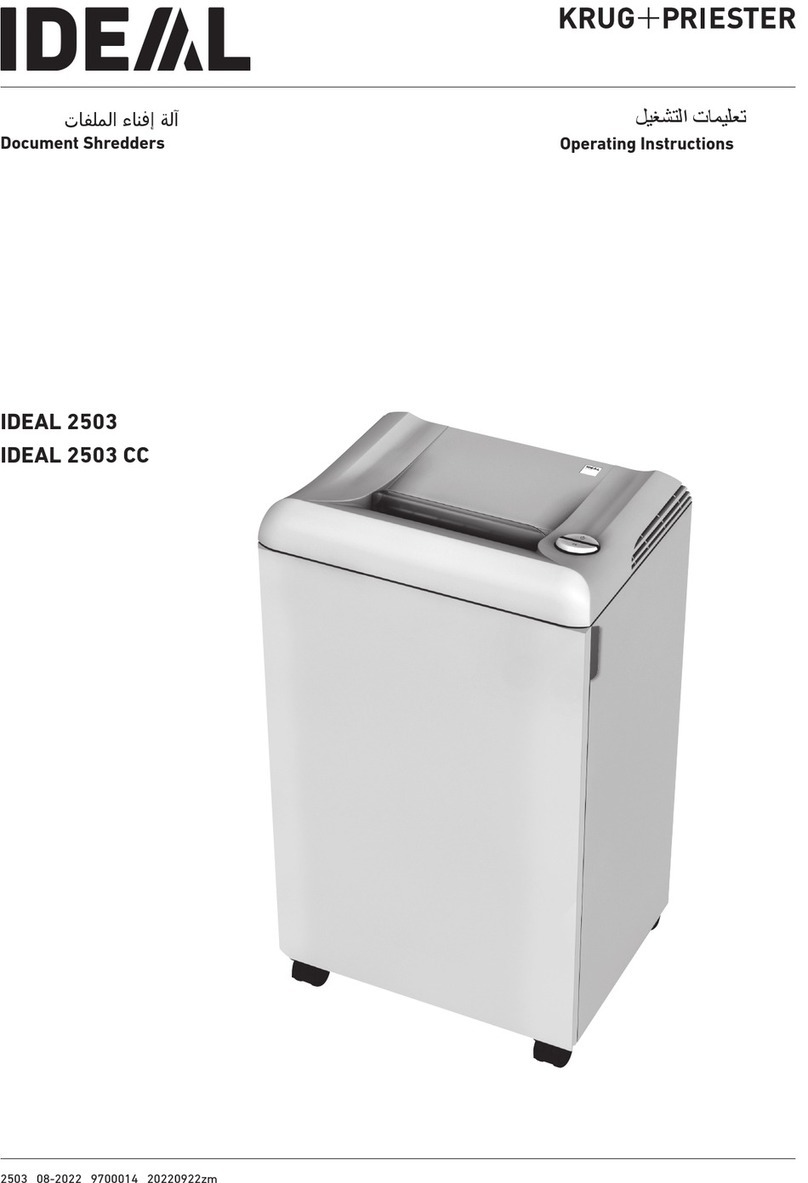
KRUG+PRIESTER
KRUG+PRIESTER IDEAL 2503 operating instructions
